Saint Patrick’s Day is just around the corner, with its usual folklore of leprechauns and Irish shamrocks! But what do you know about this famous plant? Why is she such a symbol for Green Erin? Here’s our top tip on the history of this famous “Irish shamrock”!
A plant with many facets:
- The term shamrock comes from the Irish word seamróg or seamair óg, meaning “little shamrock”.
- Originally, the shamrock was associated with the Celtic goddess Ana or Anu, the three leaves representing her status as maiden, mother and head of the family of Ireland.
- Saint Patrick used the shamrock in his Christian teachings to illustrate the Holy Trinity: each leaf designating, respectively, the Father, the Son and the Holy Spirit.
- Another tradition says that the fourth leaf of the shamrock represents luck alongside faith, hope and love.
- The chances of finding a 4-leaf clover are slim! There is 1 4-leaf clover for every 10,000 3-leaf clovers. You can try your luck at finding one, but you’ll have to be patient and rely on your lucky stars!
- If you’re lucky enough to find one, Irish tradition dictates that you cut off the 4th leaf and place it in a cup of water to grow. After a few days, plant the leaf in the grass, and the following year you’ll have a little patch of clover for good luck!
- Clover leaves are reputed to produce a red pigment called anthocyanin which, when consumed, is said to have certain health benefits.
The clover is therefore a complete little plant, with nutritional virtues as well as a symbol of good luck and religious history. In Ireland, it’s one of the country’s must-have folk attributes!
To discover at the moment
